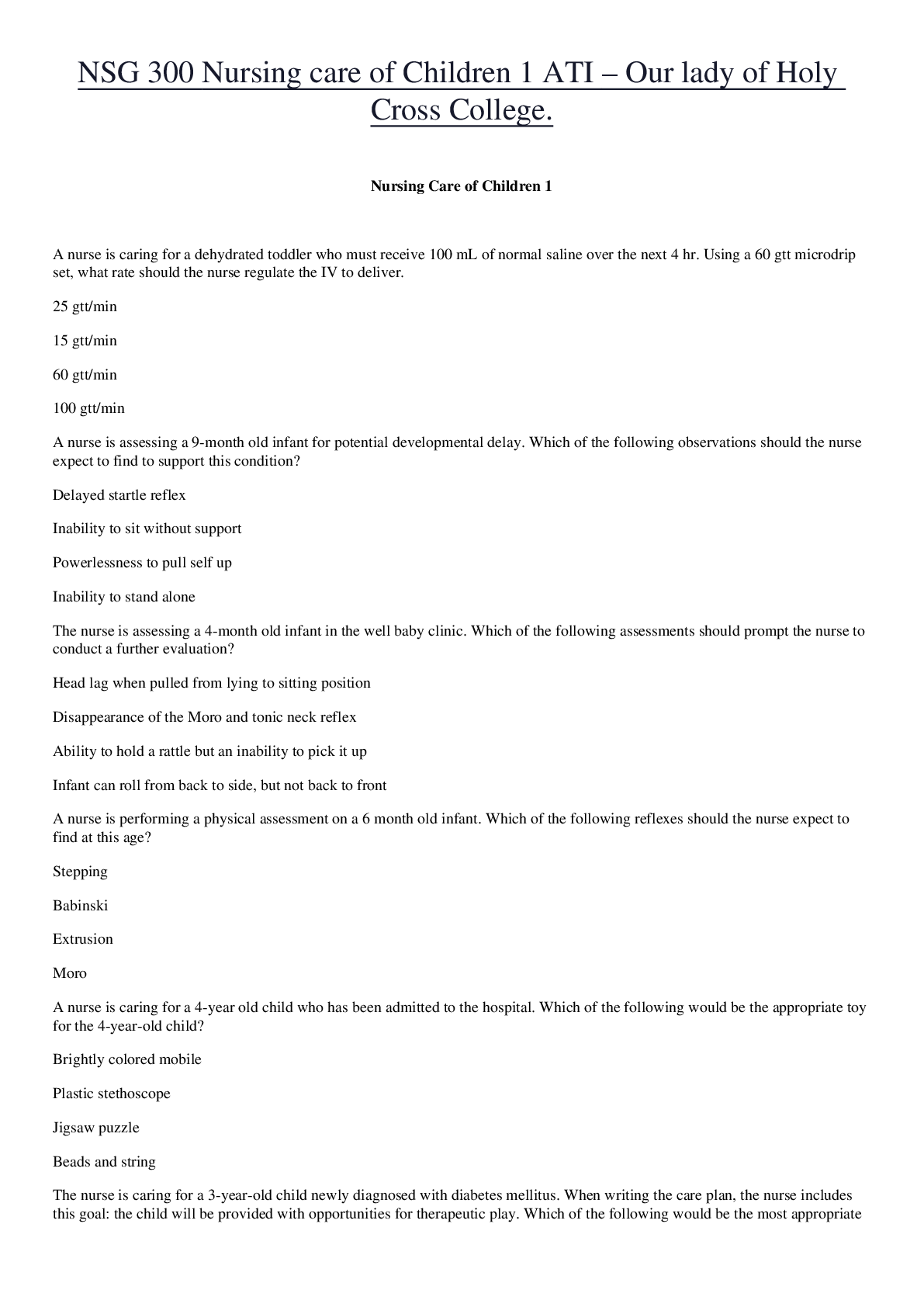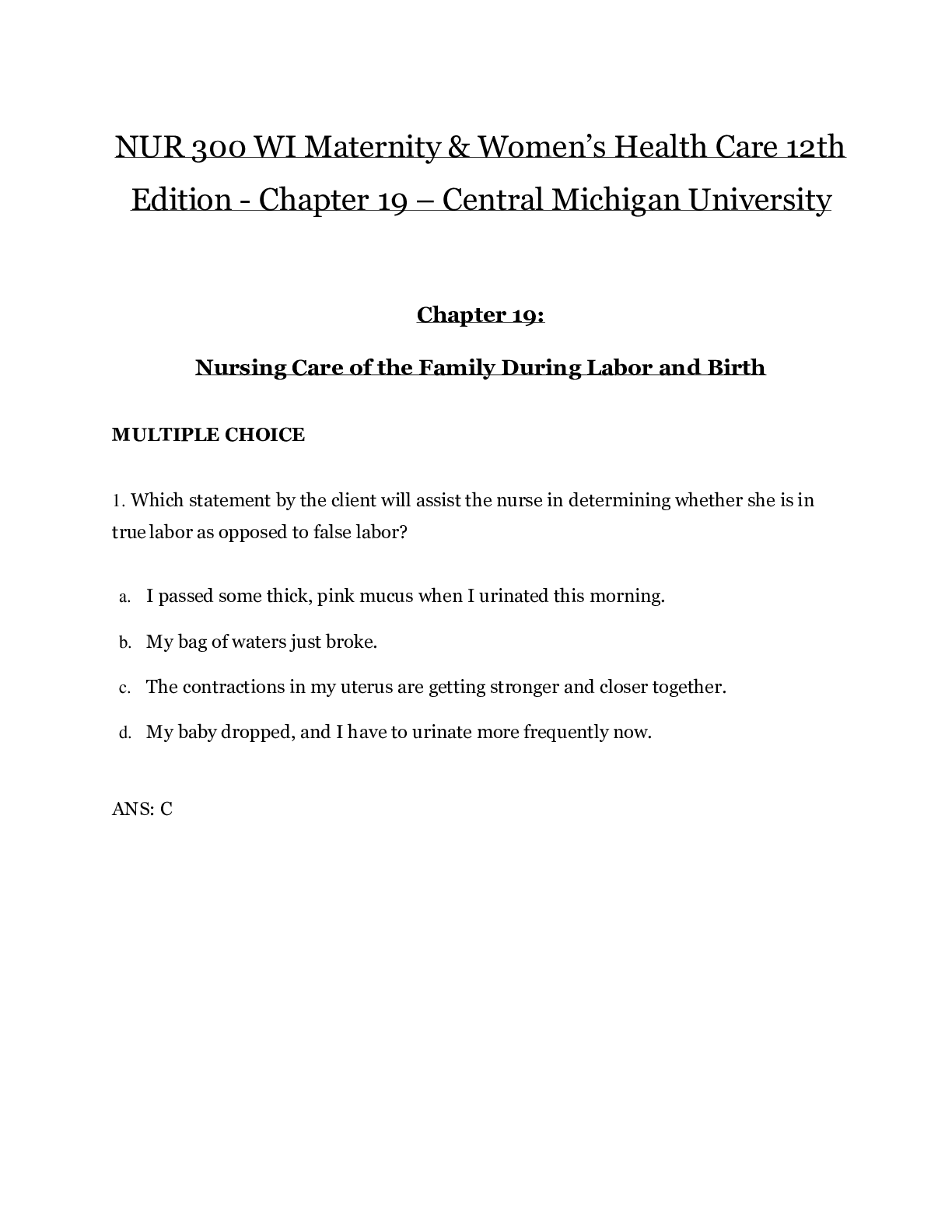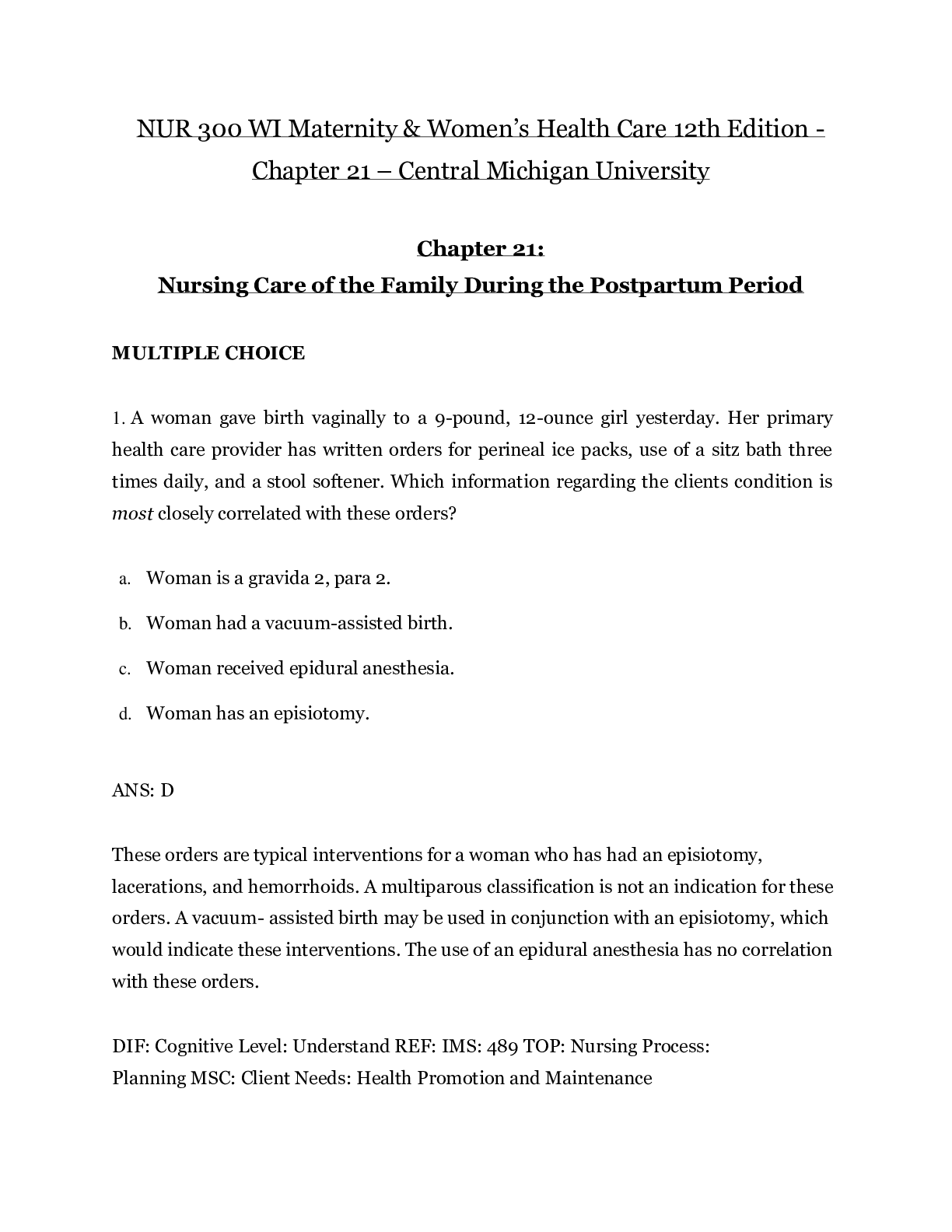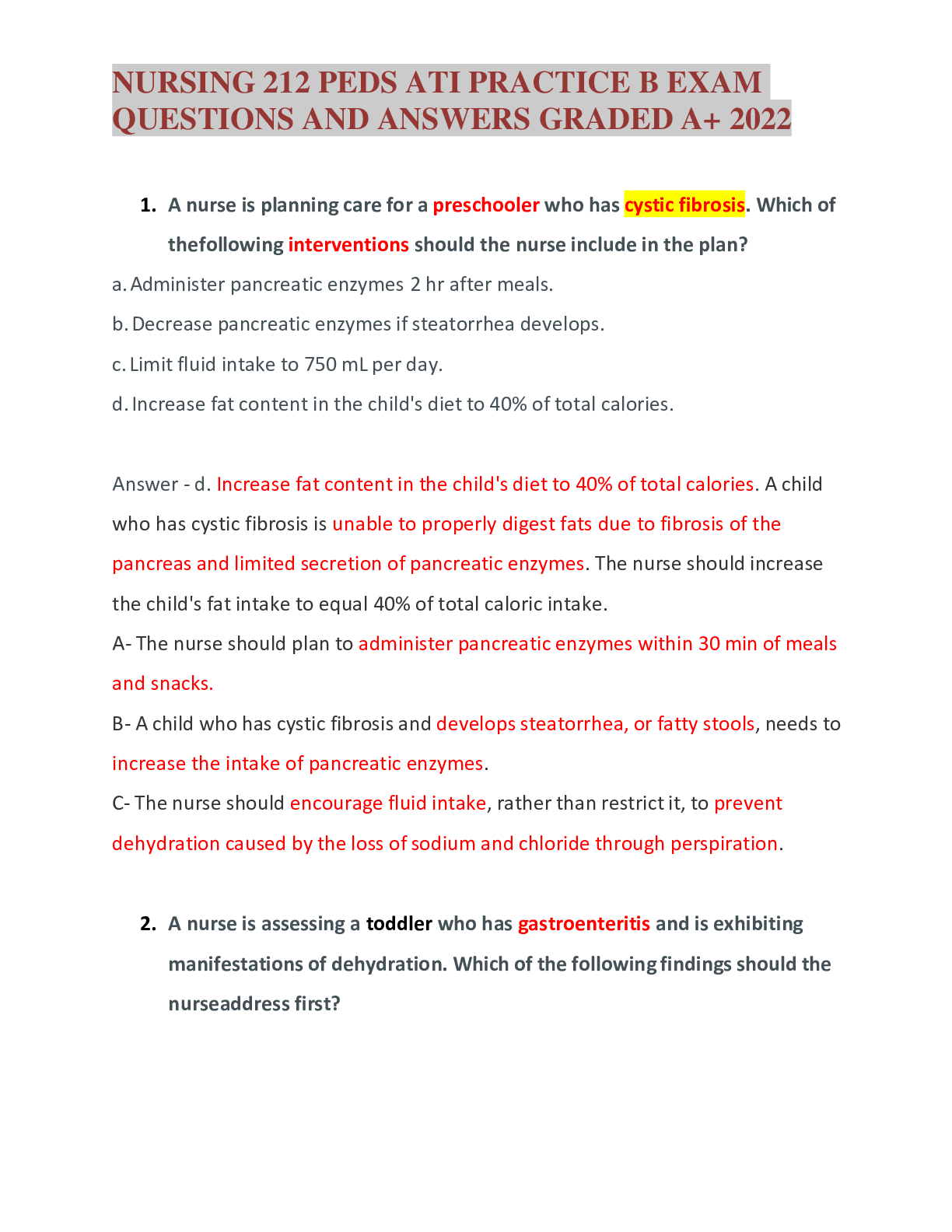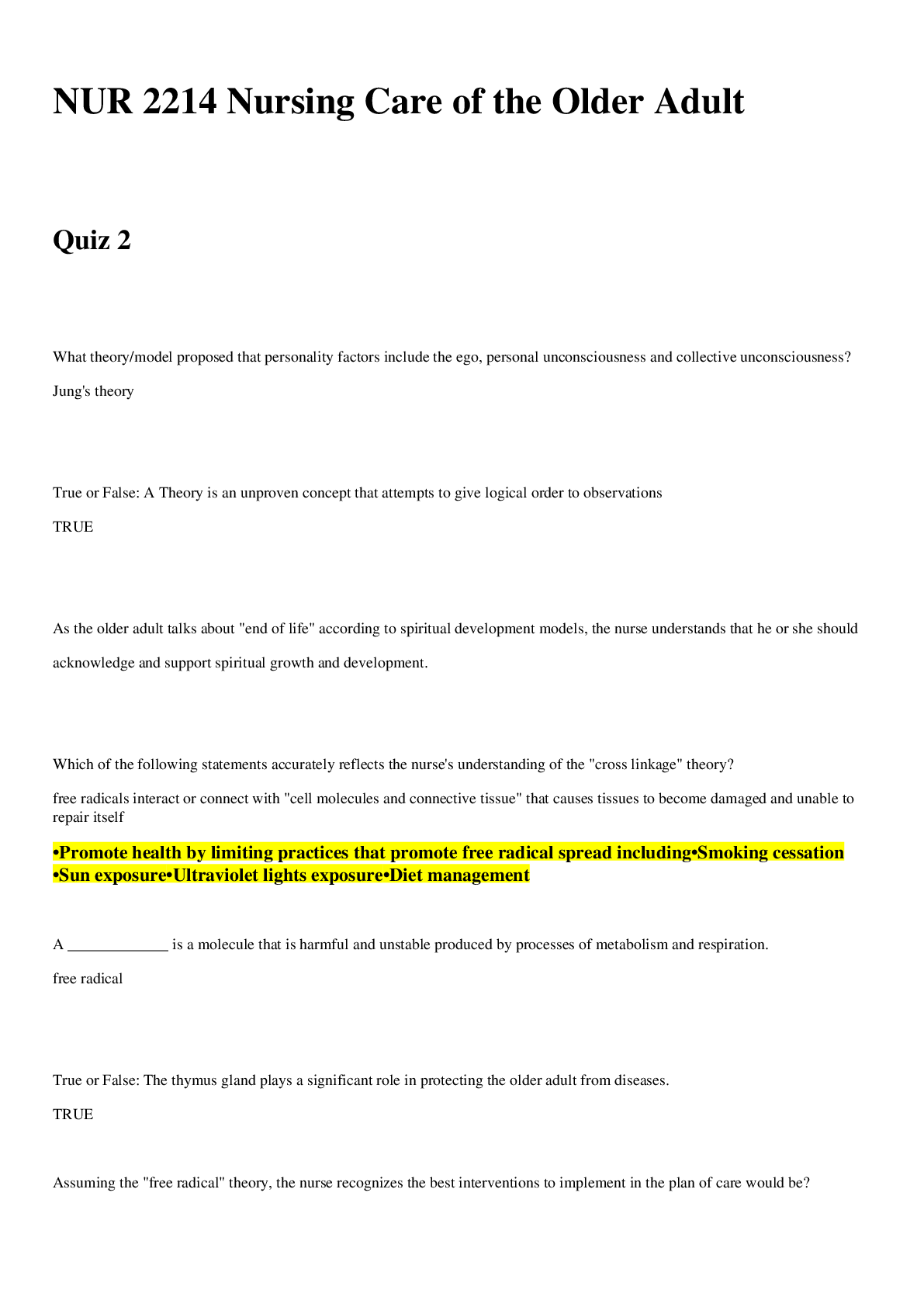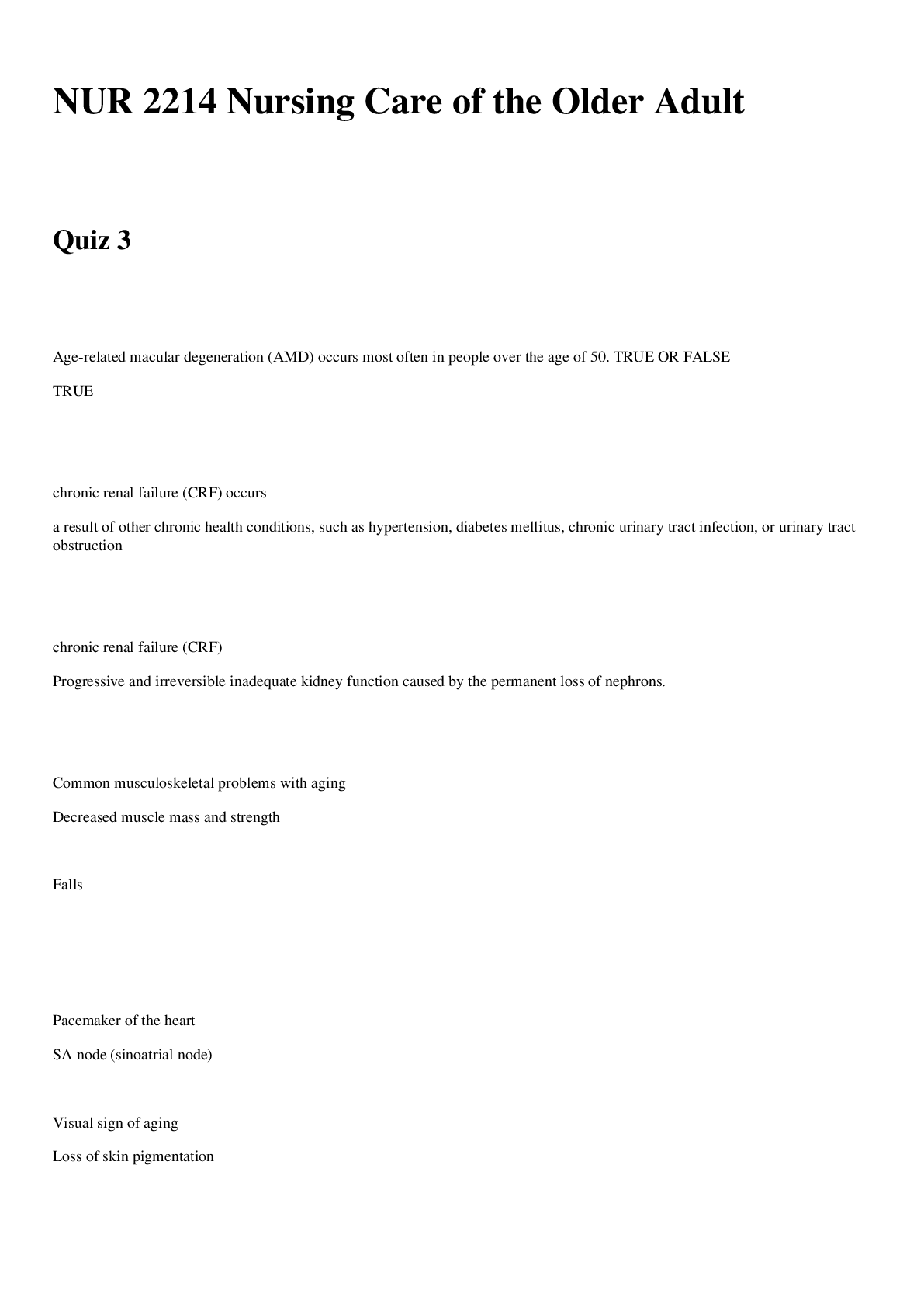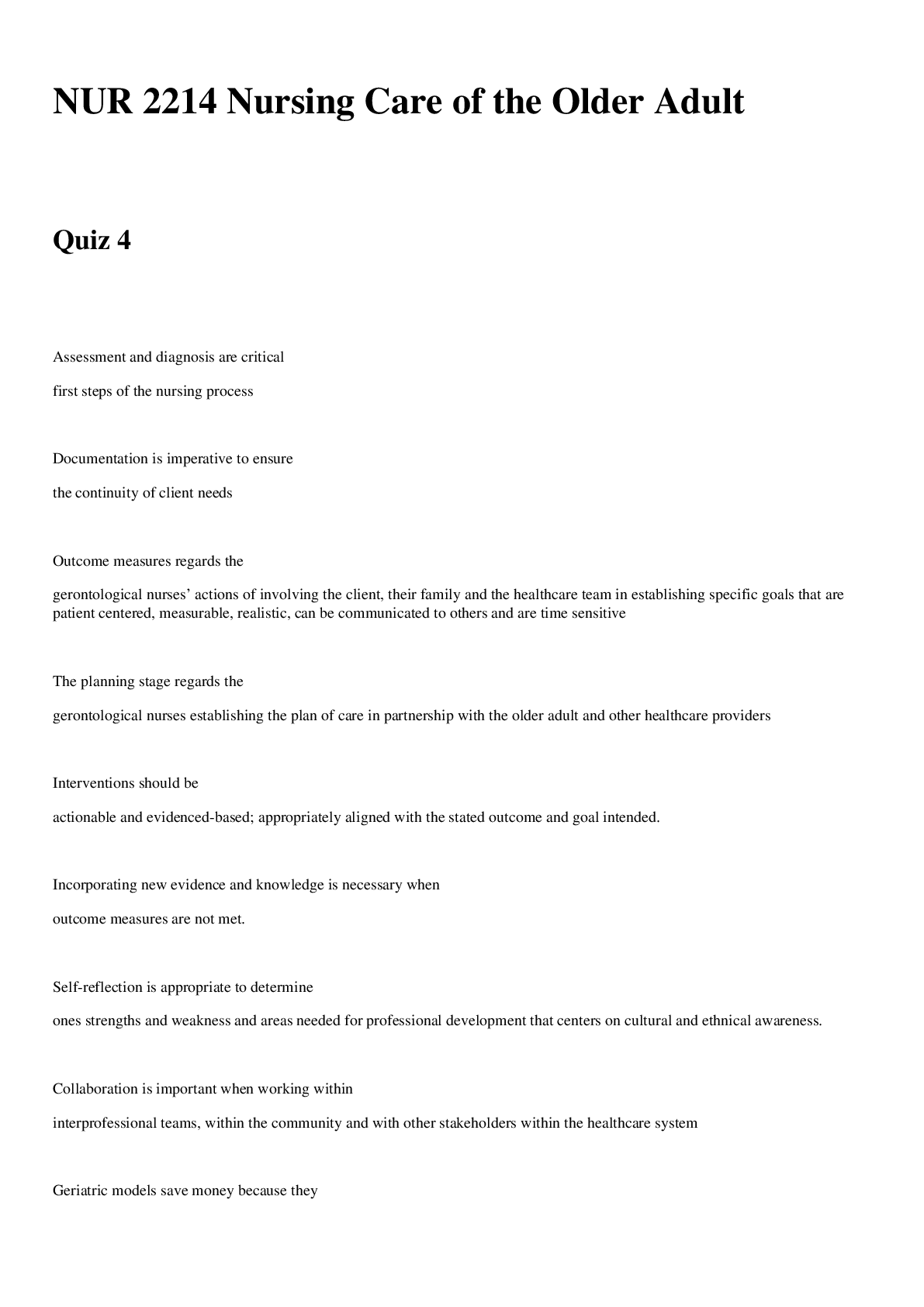Chapter 33. Nursing Care of Patients With Upper Gastrointestinal Disorders
Document Content and Description Below
Chapter 33. Nursing Care of Patients With Upper Gastrointestinal Disorders Multiple Choice Identify the choice that best completes the statement or answers the question. 1. The nurse... is caring for a patient with a sliding hiatal hernia. In which position should the nurse expect the patient to report that the symptoms are more acute? a. Sitting b. Standing c. Lying down d. Semi-Fowlers 2. The nurse is reinforcing teaching provided to a patient with a hiatal hernia. Which patient statement indicates a correct understanding of lifestyle modification to reduce symptoms? a. Avoid high-stress situations. b. Perform daily aerobic exercise. c. Avoid nicotine and alcohol use. d. Carefully space activity periods with rest. 3. The nurse teaching a patient with gastroesophageal reflux about the influence of body position on the disease process. Which patient statement indicates that teaching has been effective? a. I elevate the head of the bed 4 to 6 inches. b. I elevate the foot of the bed 12 to 16 inches. c. I sleep on my back without a pillow under my head. d. I sleep on my stomach with my head turned to the left. 4. A patient with a duodenal peptic ulcer vomits old blood. What description should the nurse use to document the appearance of the vomitus? a. Duodenal fecal matter b. Coffee-ground particles c. Undigested particles of food d. Chyme streaked with a black syrupy material 5. The nurse is caring for a patient on a gastrointestinal unit. Which patient statement should cause the nurse the most concern? a. My stool has been dark green and hard to pass lately. b. Lately, Ive had two or three loose, sticky black stools every day. c. Usually I move my bowels every day and the stool is light brown. d. My stool is soft and dark brown; I usually move my bowels twice a day. 6. The nurse is reinforcing teaching with a patient who had a large portion of the stomach removed. Which patient statement indicates understanding of why the patient will need to receive vitamin B12 for life? a. Sickle cell anemia b. Pernicious anemia c. Iron-deficiency anemia d. Acquired hemolytic anemia 7. A patient with a nasogastric tube to low intermittent suction after surgery begins to vomit bright red blood. Which action should the nurse take first? a. Administer oxygen. b. Irrigate the nasogastric tube. c. Increase the intravenous rate. d. Turn the patient onto his or her side. 8. The nurse is teaching a patient about gastric surgery and dumping syndrome. Which statement indicates that the patient understands dumping syndrome? a. I need to eat small frequent meals. b. I should drink lots of fluids with meals. c. I need to sit up for 2 hours after each meal. d. I can expect the symptoms to begin 2 hours after eating. 9. A patient with a hiatal hernia is experiencing heartburn. Which should the nurse suggest to this patient? a. Eat large meals. b. Avoid bedtime snacks. c. Sleep flat without a pillow. d. Recline 1 hour before meals. 10. The nurse is caring for a patient with a vented nasogastric tube ordered to suction after a gastrectomy. What type of suction should the nurse use to decrease the development of complications? a. Continuous low suction b. Continuous high suction c. Intermittent low suction d. Intermittent high suction 11. The nurse is caring for a patient with gastroesophageal reflux disease (GERD). Which patient statement indicates a need for nutritional instruction? a. I should drink milk, as it is the perfect food. b. Nutrition can affect health positively or negatively. c. Excessive intake of a nutrient can interfere with others. d. Classes of nutrients are carbohydrates, fats, proteins, vitamins, minerals, and water. 12. The nurse is caring for a patient recovering from radical neck dissection for cancer and tracheostomy placement. What action by the nurse should take priority? a. Ensuring airway patency b. Ensuring adequate nutrition c. Teaching about smoking cessation d. Establishing ways of communication 13. The nurse is reinforcing teaching provided to a patient scheduled for pyloroplasty. Which patient statement indicates a correct understanding of the procedure? a. The doctor will stitch the top of my stomach to help me lose weight. b. The doctor will cut the nerve that goes to my stomach so less acid is released. c. The pylorus will be narrowed to prevent gastric reflux and help my ulcers heal. d. The surgery will improve the movement of food from my stomach to my small intestine. 14. A patient is recovering from a Billroth I procedure and has a nasogastric Levin tube set to low intermittent suction. As the patient turns in bed, the Levin tube is partially pulled out. Which action should the nurse take? a. Notify the registered nurse (RN). b. Irrigate the tube. c. Advance the tube. d. Place suction on continuous. 15. The nurse is providing care to a patient 3 days after a Billroth I procedure. About which observation should the nurse be most concerned? a. Pulse 58 beats per minute b. Incisional pain score 4 on a 1 to 10 scale c. Patient becomes tearful while viewing the incision d. Reports of abdominal cramping shortly after eating 16. The nurse is reinforcing teaching provided to a patient with dumping syndrome. Which patient statement indicates a correct understanding of this condition? a. It is delayed gastric emptying. b. Glucose is dumped into the bloodstream. c. Digestive secretions enter the esophagus. d. There is rapid entry of food into the jejunum. 17. The nurse is reinforcing teaching provided to a patient with a peptic ulcer. Which patient statement indicates understanding of the medication ranitidine (Zantac)? a. It clings to the ulcer. b. It coats your stomach. c. It neutralizes stomach acid. d. It reduces production of gastric acid. 18. The nurse is caring for a patient who suddenly begins having large amounts of bright red hematemesis. After the patient is turned onto the side, what should the nurse do? a. Encourage iced oral fluids. b. Lower the head of the bed. c. Obtain the patients vital signs. d. Place a cool cloth on the patients forehead. 19. The nurse is checks the gastric pH and provides antacids as prescribed to a patient recovering from a motor vehicle crash. What is the nurse attempting to prevent by these interventions? a. Shock b. Stress ulcers c. Malnutrition d. Metabolic acidosis 20. The nurse is caring for a patient who has a nasogastric tube in place following gastric surgery. Why should the nurse use normal saline to irrigate the nasogastric tube? a. It decreases electrolytes. b. It maintains electrolytes. c. It maintains fluid volume. d. It increases fluid volume. 21. The nurse is caring for a patient who has developed esophagitis from gastroesophageal reflux disease (GERD). For which additional complication should the nurse anticipate providing care to this patient? a. Laryngospasm b. Bronchospasm c. Barretts esophagus d. Aspiration pneumonia 22. The nurse is collecting data for a patient who is taking Prevacid for peptic ulcer disease. Which data collection finding requires immediate intervention? a. A rash b. Tarry stools c. Constipation d. Changes in mental status 23. A patient who is unconscious begins to vomit blood. What action should the nurse take first? a. Turn patient onto side. b. Use water to rinse out mouth. c. Provide oral care to the patient. d. Administer antiemetic medication. 24. The nurse is contributing to a patients teaching plan on how to avoid dumping syndrome after a gastrectomy. What should be included in the teaching? a. Avoid fluids with meals. b. Increase activity after eating. c. Increase carbohydrate intake. d. Eat heavy meals to delay emptying. 25. A patient with a nasogastric tube connected to suction is NPO (nothing by mouth) and reports a dry mouth and gagging feeling. What action should the nurse take? a. Provide oral care. b. Pull tube out 1 inch. c. Offer ice chips to swallow. d. Give lidocaine solution to coat the mouth. 26. The nurse is caring for a patient with bulimia. Which complication should the nurse recognize that this patient is at risk for developing? a. Weight gain b. Fluid overload c. Ischemic stroke d. Metabolic alkalosis 27. The nurse is reinforcing teaching provided to a patient being tested for type B gastritis. Which patient statement indicates a correct understanding of the test that is used to diagnose this condition? a. Colonoscopy. b. Barium enema. c. Abdominal x-ray. d. Esophagogastroduodenoscopy. 28. The nursing assistant is delivering patient meals. Which meal should the nurse expect to be delivered to a patient who had gastric bypass surgery the day before? a. Soft diet b. Full liquids c. Clear liquids d. General diet 29. The nurse is caring for a patient who complains of nausea related to gastric cancer. Which supplement should the nurse suggest? a. Ginger b. Lemon c. Butterscotch d. Black licorice 30. The nurse is preparing to calculate a patients body mass index. What measurements does the nurse need to make this calculation? a. Height and weight b. Waist and hip measurements c. Weight and waist measurement d. Waist measurement and height 31. The nurse is evaluating care provided to a patient with bulimia nervosa. Which observation indicates that addition care is required? a. Patient sits and talks with others after eating a meal b. Patient states that looking in a mirror makes her nauseated c. Patient states importance of continuing with therapy sessions d. Patient plans meals and appropriate snacks at the beginning of the day 32. The nurse is visiting the home of a patient recovering from a sleeve gastrectomy. Which observation indicates that this surgery has been successful for the patient? a. Patient claims that she never feels hungry b. Patients skin is dry and hair is falling out c. Patient states that she is constantly hungry d. Patient has injected 100 mL of saline solution in the pouch Multiple Response Identify one or more choices that best complete the statement or answer the question. 33. The nurse is caring for a patient recovering from a bleeding gastric ulcer. Which patient statements indicate correct understanding of beverages to avoid after treatment of a bleeding gastric ulcer? (Select all that apply.) a. Beer b. Milk c. Coffee d. Iced tea e. Lemonade f. Diet soda pop 34. A patient is considering surgery to treat obesity. Which factors meet established criteria for the use of surgery in the treatment of obesity? (Select all that apply.) a. Hypertension b. Presence of gallstones c. Gross obesity for 5 years d. Psychiatric and social stability e. Body weight 50% above ideal weight f. Failure to reduce weight with other forms of therapy 35. The nurse has instructed a patient prescribed omeprazole (Prilosec) for peptic ulcer disease on use of the medication. What patient statements indicate understanding of the instructions? (Select all that apply.) a. I should not take antacids while Im on this medication. b. If I wish, I can open the capsule and sprinkle it on food. c. I will take the capsule before eating a meal in the morning. d. I will need to take this drug for 3 weeks for my ulcer to heal. e. I will report any abdominal pain, diarrhea, or bleeding that occurs. f. Ill have to have regular blood counts and tests of my liver enzymes. 36. The nurse is caring for a patient who has a nursing diagnosis of acute postoperative pain after a gastrectomy. The patient has a nasogastric (NG) tube. What interventions should the nurse implement? (Select all that apply.) a. Encourage total bedrest. b. Monitor NG tube functioning. c. Reposition NG tube once a shift. d. Provide pain medication as ordered. e. Start a regular diet once bowel sounds are detected. f. Evaluate pain regularly and report changes to the RN. 37. The nurse is providing care to a patient anticipating radiation therapy for head and neck cancer. What should the nurse include in pre-therapy education? (Select all that apply.) a. Water is an appropriate substitute for saliva. b. Good oral hygiene habits are important to prevent decay. c. Tooth decay occurs less frequently when oral tissues are dry. d. It is important that you visit the dentist before radiation therapy begins. e. All of your teeth will need to be pulled before you start radiation therapy. f. Artificial saliva can be used if the radiation therapy causes drying of the mouth. 38. The nurse is caring for a patient who has aphthous stomatitis. What care should the nurse provide? (Select all that apply.) a. Make patient NPO. b. Place on fluid restriction. c. Apply a topical anesthetic. d. Teach to avoid irritating foods. e. Suggest stress management techniques. 39. The nurse is participating in planning care for a patient who is experiencing nausea. Which interventions should be included in this patients plan of care? (Select all that apply.) a. Provide antiemetics as prescribed b. Ensure the environment is odor-free c. Monitor intake, output, and vital signs d. Provide oral care every 2 hours as needed e. Instruct to avoid odors or foods that precipitate nausea 40. After collecting data the nurse suspects that an adolescent patient is at risk for developing anorexia nervosa. What data did the nurse use to come to this conclusion? (Select all that apply.) a. Age 17 years b. Phobia about weight gain c. Fearful of mother present during the interview d. Asked the nurse repeatedly why certain information was needed e. Texted with friends on the smartphone while interview in progress 41. A patient with morbid obesity is admitted to the hospital for leg wounds. Which observations should the nurse expect when collecting data from this patient? (Select all that apply.) a. BMI 41 b. Hyper-excitable c. Lethargy and malaise d. Shortness of breath with walking e. Body weight 120 lbs over ideal weight Completion Complete each statement. 42. A patients ideal body weight is 150 lbs. At which weight would the nurse patient be considered obese? Chapter 33. Nursing Care of Patients With Upper Gastrointestinal Disorders Answer Section MULTIPLE CHOICE 1. ANS: C In a sliding hiatal hernia, the stomach slides up into the thoracic cavity when a patient is supine and then goes back into the abdominal cavity when upright. Sliding hiatal hernia symptoms are worse when lying down. A. B. D. The symptoms of a hiatal hernia are not worse when sitting, standing, or in the semi-Fowlers position. PTS: 1 DIF: Moderate KEY: Client Need: Physiological Integrity, Physiological Adaptation | Cognitive Level: Analysis 2. ANS: C Lifestyle changes for symptomatic hiatal hernia include losing weight, antacids, eating small meals that pass easily through the esophagus, not reclining for 3-4 hours after eating, elevating the head of the bed 6 to 12 inches to prevent reflux, and avoiding bedtime snacks, spicy foods, alcohol, caffeine, and smoking. A. B. D. Stress, exercise, and rest periods are not recommendations for the patient with a hiatal hernia. PTS: 1 DIF: Moderate KEY: Client Need: Physiological Integrity, Physiological Adaptation | Cognitive Level: Analysis 3. ANS: A Elevating the head of the bed 4 to 6 inches helps prevent reflux of gastric contents into the esophagus. B. The head of the bed does not need to be elevated 12 to 16 inches. C. D. Sleeping flat or on the stomach could exacerbate symptoms of gastroesophageal reflux. PTS: 1 DIF: Moderate KEY: Client Need: Physiological Integrity, Physiological Adaptation | Cognitive Level: Analysis 4. ANS: B When blood mixes with hydrochloric acid and enzymes in the stomach, a dark, granular material resembling coffee grounds is produced. This indicates old bleeding, as fresh bleeding would be red in color. A.C. D. The nurse should not document the appearance of the patients emesis as being duodenal fecal matter, undigested food particles or a chyme mixture. PTS: 1 DIF: Moderate KEY: Client Need: Physiological Integrity, Physiological Adaptation | Cognitive Level: Application 5. ANS: B The nurse should be most concerned if there were evidence of blood loss causing black tarry stools (melena). A. Stool that is dark green and hard to pass could indicate constipation caused by an iron preparation. C. D. More information is needed before becoming concerned about these descriptions. PTS: 1 DIF: Moderate KEY: Client Need: Physiological Integrity, Physiological Adaptation | Cognitive Level: Analysis 6. ANS: B Vitamin B12 deficiency can occur after some or all of the stomach is removed because intrinsic factor secretion is reduced or gone. Normally, vitamin B12 combines with intrinsic factor to prevent its digestion in the stomach and promote its absorption in the intestines. Lifelong administration of vitamin B12 is required to prevent the development of pernicious anemia. A. C. D. Removal of part of the stomach will not lead to the development of sickle cell anemia, iron-deficiency anemia, or acquired hemolytic anemia. PTS: 1 DIF: Moderate KEY: Client Need: Physiological Integrity, Reduction of Risk Potential | Cognitive Level: Analysis 7. ANS: D Protection of the airway during vomiting is a priority to prevent aspiration. Those at risk of aspiration are persons who are unconscious, older, and experiencing gag reflex impairments. Place these types of persons on their side when they begin to vomit. This allows the gastric contents to be expelled from the mouth rather than pooling at the back of the throat and being aspirated. A. The patient does not necessarily need oxygen at this time. B. The patient could aspirate while the nurse is irrigating the nasogastric tube. C. There is no reason to increase the patients intravenous infusion at this time. PTS: 1 DIF: Moderate KEY: Client Need: Physiological Integrity, Reduction of Risk Potential | Cognitive Level: Application 8. ANS: A Treatment for dumping syndrome includes teaching the patient to eat small, frequent meals that are high in protein and fat and low in carbohydrates, especially refined sugars. B. The patient should be taught to avoid fluids 1 hour before meals, with meals, or for 2 hours after meals to prevent rapid gastric emptying. C. It is bes for the patient to lie down after meals to delay gastric emptying. D. The symptoms occur 5 to 30 minutes after eating. PTS: 1 DIF: Moderate KEY: Client Need: Physiological Integrity, Physiological Adaptation | Cognitive Level: Analysis 9. ANS: B Treatment for hiatal hernia includes avoiding bedtime snacks. A. Small meals that pass easily through the esophagus should be eaten. C. The head of the bed should be elevated 6 to 12 inches to prevent reflux. D. Reclining for 1 hour after eating should be avoided. PTS: 1 DIF: Moderate KEY: Client Need: Physiological Integrity, Reduction of Risk Potential | Cognitive Level: Application 10. ANS: C With a physicians order, the nasogastric tube is connected to suction equipment, usually set on low intermittent suction if the secretions are not too thick, to prevent injury to the gastric mucosa. The vent also helps prevent this injury. A. B. D. These settings for suction might cause injury to the gastric mucosa. PTS: 1 DIF: Moderate KEY: Client Need: Physiological Integrity, Reduction of Risk Potential | Cognitive Level: Application 11. ANS: A A low-fat, high-protein diet is recommended because fat causes decreased functioning of the lower esophageal sphincter. Caffeine, milk products, and spicy foods should be avoided. B. C. D. These patient statements are appropriate for the patient with gastroesophageal reflux disease. PTS: 1 DIF: Moderate KEY: Client Need: Physiological Integrity, Basic Care and Comfort | Cognitive Level: Analysis 12. ANS: A A tracheostomy is usually performed to protect the airway and prevent obstruction. The airway must be monitored and secretions controlled to prevent aspiration. B. C. D. These actions are important however do not take the priority over maintaining a patent airway. PTS: 1 DIF: Moderate KEY: Client Need: Physiological Integrity, Reduction of Risk Potential | Cognitive Level: Analysis 13. ANS: D Pyloroplasty widens the exit of the pylorus to improve emptying of the stomach. A. Suturing part of the stomach is part of Bariatric surgery. B. Cutting the nerve to the stomach is a vagotomy. C. There is no surgery to narrow the pylorus. PTS: 1 DIF: Moderate KEY: Client Need: Physiological Integrity, Physiological Adaptation | Cognitive Level: Analysis 14. ANS: A The nurse needs to inform the RN or physician because the tube will need to be repositioned. The physician typically is the one that does the repositioning after gastric surgery so the suture line is not affected. B. C. D. The nurse should not irrigate the tube, advance the tube, or place the tube on continuous suction since these actions could injure the suture line. PTS: 1 DIF: Moderate KEY: Client Need: Safe and Effective Care Environment, Safety and Infection Control | Cognitive Level: Application 15. ANS: D Dumping syndrome is a complication of Billroth I procedure and occurs 5 to 30 minutes after eating. Symptoms include dizziness, tachycardia, fainting, sweating, nausea, diarrhea, a feeling of fullness, and abdominal cramping. A. A pulse of 58 beats per minute could be within the patients normal pulse range. B. C. Pain and the emotional reaction to the incision are psychosocial concerns and are not the highest priority at this time. PTS: 1 DIF: Moderate KEY: Client Need: Physiological Integrity, Physiological Adaptation | Cognitive Level: Analysis 16. ANS: D Dumping syndrome occurs with the rapid entry of food into the jejunum without proper mixing of the food with digestive juices. On entering the jejunum, the food draws extracellular fluid into the bowel from the circulating blood volume to dilute the high concentration of electrolytes and sugars. A. Delayed gastric emptying does not described dumping syndrome. B. With dumping syndrome glucose is not dumped into the blood stream. C. Digestive secretions entering the esophagus describe gastroesophageal reflux disease. PTS: 1 DIF: Moderate KEY: Client Need: Physiological Integrity, Physiological Adaptation | Cognitive Level: Analysis 17. ANS: D Zantac reduces production of gastric acid, which aids in healing the ulcer. A. B. C. These statements do not explain the purpose or mechanism of Zantac. PTS: 1 DIF: Moderate KEY: Client Need: Physiological Integrity, Pharmacological and Parenteral Therapies | Cognitive Level: Analysis 18. ANS: C The nurse should collect data, including vital signs, to report to the RN and physician for treatment orders. A. The nurse should not give the patient anything by mouth. B. Lowering the head of the bed could lead to aspiration. D. Placing a cool cloth on the patients forehead might be offered after the physician and RN have been notified. PTS: 1 DIF: Moderate KEY: Client Need: Physiological Integrity, Reduction of Risk Potential | Cognitive Level: Application 19. ANS: B Critically ill patients may develop gastric or small intestinal stress ulcers from ischemia. The stress response to the illness causes reduced blood flow to the stomach and small intestine. A. C. D. These interventions are not done to prevent the development of shock, malnutrition, or metabolic acidosis. PTS: 1 DIF: Moderate KEY: Client Need: Physiological Integrity, Reduction of Risk Potential | Cognitive Level: Analysis 20. ANS: B Normal saline is used for irrigation to prevent electrolyte loss and imbalance. A. C. D. Irrigating a nasogastric tube with normal saline is not done to decrease electrolytes, maintain fluid volume, or increase fluid volume. PTS: 1 DIF: Moderate KEY: Client Need: Physiological Integrity, Physiological Adaptation | Cognitive Level: Analysis 21. ANS: C Complications of GERD can result in esophagitis. Over time, this can lead to changes in the epithelium of the esophagus and lead to Barretts esophagus, a precancerous lesion. A. B. D. Laryngospasm, bronchospasm, and aspiration pneumonia are not complications typically associated with gastroesophageal reflux disease. PTS: 1 DIF: Moderate KEY: Client Need: Physiological Integrity, Reduction of Risk Potential | Cognitive Level: Application 22. ANS: B With Prevacid administration, the nurse should assess for epigastric or abdominal pain and for blood in stool (tarry stools), emesis, or gastric aspirate. Notify the physician if any evidence of bleeding has occurred. A. C. D. Rash, constipation, and mental status changes are not identified adverse effects of Prevacid. PTS: 1 DIF: Moderate KEY: Client Need: Physiological Integrity, Pharmacological and Parenteral Therapies | Cognitive Level: Analysis 23. ANS: A If vomiting occurs, turn the patient onto his or her side to protect the airway and prevent aspiration. B. The patient is unconscious so water should not be placed into the patients mouth. C. Oral care can be done after the airway has been protected. D. Antiemetic medication requires a physicians order which may or may not be available at this time. PTS: 1 DIF: Moderate KEY: Client Need: Physiological Integrity, Reduction of Risk Potential | Cognitive Level: Application 24. ANS: A To avoid dumping syndrome, avoid fluids 1 hour before, with, or for 2 hours after meals to prevent rapid gastric emptying. B. The patient should rest after eating. C. Carbohydrates should be limited. D. The patient should eat small frequent meals. PTS: 1 DIF: Moderate KEY: Client Need: Physiological Integrity, Reduction of Risk Potential | Cognitive Level: Application 25. ANS: A Frequent oral care is needed for comfort for patients who are NPO with NG tubes as dry mouth is a continual concern. B. The nurse should not reposition the patients nasogastric tube. C. The patient is NPO so ice chips would be contraindicated. D. There is no reason to provide lidocaine for the patients mouth. PTS: 1 DIF: Moderate KEY: Client Need: Physiological Integrity, Basic Care and Comfort | Cognitive Level: Application 26. ANS: D The loss of hydrochloric acid from the stomach due to vomiting can result in metabolic alkalosis. A. B. C. This patient is not at any particular risk for developing weight gain, fluid overload, or ischemic stroke. PTS: 1 DIF: Moderate KEY: Client Need: Physiological Integrity, Reduction of Risk Potential | Cognitive Level: Analysis 27. ANS: D Type B gastritis can also be diagnosed by endoscopy, upper gastrointestinal x-ray examination, and gastric aspirate analysis. A. B. C. Colonoscopy, barium enema, and abdominal x-ray are not used to diagnose type B gastritis. PTS: 1 DIF: Moderate KEY: Client Need: Physiological Integrity, Reduction of Risk Potential | Cognitive Level: Analysis 28. ANS: C Patients are started on a clear liquid diet because of the small stomach pouch that has been created. A. B. The patient will progress to these diets over the next days. D. This patient will not be provided with a general diet for quite a while. PTS: 1 DIF: Moderate KEY: Client Need: Safe and Effective Care Environment, Management of Care | Cognitive Level: Application 29. ANS: A It has been believed that ginger can be an effective aid in relieving nausea in cancer patients receiving chemotherapy, pregnant patients, and postoperative patients. Research however did not find this to be so. Even so, patients might have some relief from using ginger for nausea. B. C. D. These supplements are not identified as helping with nausea. PTS: 1 DIF: Moderate KEY: Client Need: Physiological Integrity, Basic Care and Comfort | Cognitive Level: Application 30. ANS: A Height and weight are used to calculate body mass index. B. Waist and hip measurements are used to calculate waist-to-hip ratio. C. D. There are no calculations that use weight and waist measurement or waist measurement and height. PTS: 1 DIF: Moderate KEY: Client Need: Health Promotion and Maintenance | Cognitive Level: Application 31. ANS: B If looking in the mirror makes the patient nauseated, the patient is not developing a positive self-image and would need additional interventions for this area. A. Talking with others after a meal indicates that the patient is not purging after eating. C. Stating the importance of continuing with therapy sessions indicates that the patient sees the value of meeting with someone to talk about feelings and behaviors. D. Planning meals and snacks indicates the patient is not binging. PTS: 1 DIF: Moderate KEY: Client Need: Psychosocial Integrity | Cognitive Level: Analysis 32. ANS: A Laparoscopic sleeve gastrectomy removes about 75% of the stomach to leave a slim gastric sleeve. This reduces the stomachs volume and limits food intake at one time. It also may decrease the hormone produced by the stomach that causes hunger. B. Dry skin and hair falling out indicates that the patient is not taking in an adequate amount of nutrients to support the skin and hair. C. Being constantly hungry indicates that the surgery was not successful since the hormone produced by the stomach that causes hunger should be reduced from this surgery. D. There is no saline solution injected into a pouch with this surgery. PTS: 1 DIF: Moderate KEY: Client Need: Physiological Integrity, Reduction of Risk Potential | Cognitive Level: Analysis MULTIPLE RESPONSE 33. ANS: A, C, D, F Foods known to cause discomfort such as spicy foods, carbonated drinks, caffeinated products, and alcohol, should be avoided during the healing period. B. E. There is no reason for the patient to abstain from milk or lemonade. PTS: 1 DIF: Moderate KEY: Client Need: Physiological Integrity, Reduction of Risk Potential | Cognitive Level: Analysis 34. ANS: A, C, D, F Patients who do not respond to medical methods of weight loss, who weigh 100 pounds over ideal body weight, or have a BMI over 40, or BMI over 35 with severe health effects as a result, might be candidates for surgical weight loss. Additional screening for psychiatric and social stability is required. B. E. Gallstones and percentage of body weight are not criteria for Bariatric surgery. PTS: 1 DIF: Moderate KEY: Client Need: Physiological Integrity, Reduction of Risk Potential | Cognitive Level: Analysis 35. ANS: C, E, F The patient should be instructed to take before meal in morning and notify the physician if bleeding, diarrhea, headache, or abdominal pain develops. The patient will need to have complete blood counts and liver enzymes routinely assessed when taking this medication. A. This medication may be taken with antacids. B. The capsule should be swallowed whole. D. This medication must be taken 4 to 8 weeks for ulcer healing. PTS: 1 DIF: Moderate KEY: Client Need: Physiological Integrity, Pharmacological and Parenteral Therapies | Cognitive Level: Analysis 36. ANS: A, B, D Pain should be monitored and evaluated hourly while awake. Maintaining NG tube function prevents distention and pain due to pressure on the suture line. Giving pain medication as needed is essential. C. The nurse does not reposition the NG tube after gastric surgery, and it would not be repositioned once a shift. A. The patient should be up and ambulating as soon as ordered to prevent complications. E. After removal of the NG tube, clear fluids may be ordered with progression to full liquids, soft food, and then a regular diet as the patient tolerates. PTS: 1 DIF: Moderate KEY: Client Need: Physiological Integrity, Basic Care and Comfort | Cognitive Level: Application 37. ANS: B, D, F The importance of daily and ongoing oral care should be considered for all patients. Prior to any radiation therapy of the head or neck area, a thorough oral examination and any needed restorative dental procedures should be completed. An artificial saliva substitute should be considered for patients with xerostomia (dry mouth). C. Xerostomia can lead to rampant tooth decay in older adults, putting their dentition at risk. A. Water does not contain the necessary compounds such as lubricants to protect the teeth. E. Teeth do not need to be pulled prior to radiation therapy. PTS: 1 DIF: Moderate KEY: Client Need: Physiological Integrity, Reduction of Risk Potential | Cognitive Level: Application 38. ANS: C, D, E Aphthous stomatitis appears as small, white, painful ulcers on the inner cheeks, lips, tongue, gums, palate, or pharynx and typically lasts for several days to 2 weeks. Self-induced trauma such as biting the lips and cheeks can cause these ulcers to develop, as well as stress or exposure to irritating foods. Application of topical tetracycline several times a day usually shortens the healing time. A topical anesthetic such as benzocaine or lidocaine provides pain relief and makes it possible to eat with minimal pain. A. The patient does not need to be NPO. B. A fluid restriction is not necessary. PTS: 1 DIF: Moderate KEY: Client Need: Physiological Integrity, Basic Care and Comfort | Cognitive Level: Application 39. ANS: A, B, D, E To provide comfort for the patient with nausea the nurse should provide antiemetics as prescribed to relieve nausea, ensure the environment is odor-free to avoid triggering stimuli, provide oral care to remove taste of emesis and enhance patient comfort, and instruct to avoid odors or foods that precipitate nausea. C. Monitoring intake, output, and vital signs would be appropriate if the patient were at risk for fluid volume deficit. PTS: 1 DIF: Moderate KEY: Client Need: Physiological Integrity, Basic Care and Comfort | Cognitive Level: Application 40. ANS: A, B, C, D Anorexia nervosa is an eating disorder recognized by the American Psychiatric Association. This disease most commonly occurs in females between ages 12 and 18 who are from the middle and upper classes of Western culture. Young women with low self-esteem seem to be at highest risk. Anorexia nervosa is thought to be psychological in origin. Patients may have a phobia about weight gain, be afraid of a loss of control, and be mistrusting. E. Texting with friends does not suggest that the patient is at risk for developing anorexia nervosa. PTS: 1 DIF: Moderate KEY: Client Need: Psychosocial Integrity | Cognitive Level: Analysis 41. ANS: A, D, E Obesity that interferes with activities of daily living such as breathing or walking is considered as being morbid obesity. Morbid obesity refers to people whose BMI is above 40, which is about 100 lb overweight for men and about 80 lb overweight for women. B. Hyper-excitable is not a manifestation of morbid obesity. C. Lethargy and malaise are not identified as manifestations of morbid obesity. PTS: 1 DIF: Moderate KEY: Client Need: Physiological Integrity, Reduction of Risk Potential | Cognitive Level: Application COMPLETION 42. ANS: 180 A weight that is 20% over ideal weight is considered obese. Calculate this by multiplying the current weight by 20% or 150 0.20 = 30. Then add this value of 30 to the current weight of 150 lbs. The patient would need to weigh 180 lbs. to be considered obese. PTS: 1 DIF: Moderate KEY: Client Need: Health Promotion and Maintenance | Cognitive Level: Application [Show More]
Last updated: 1 year ago
Preview 1 out of 33 pages
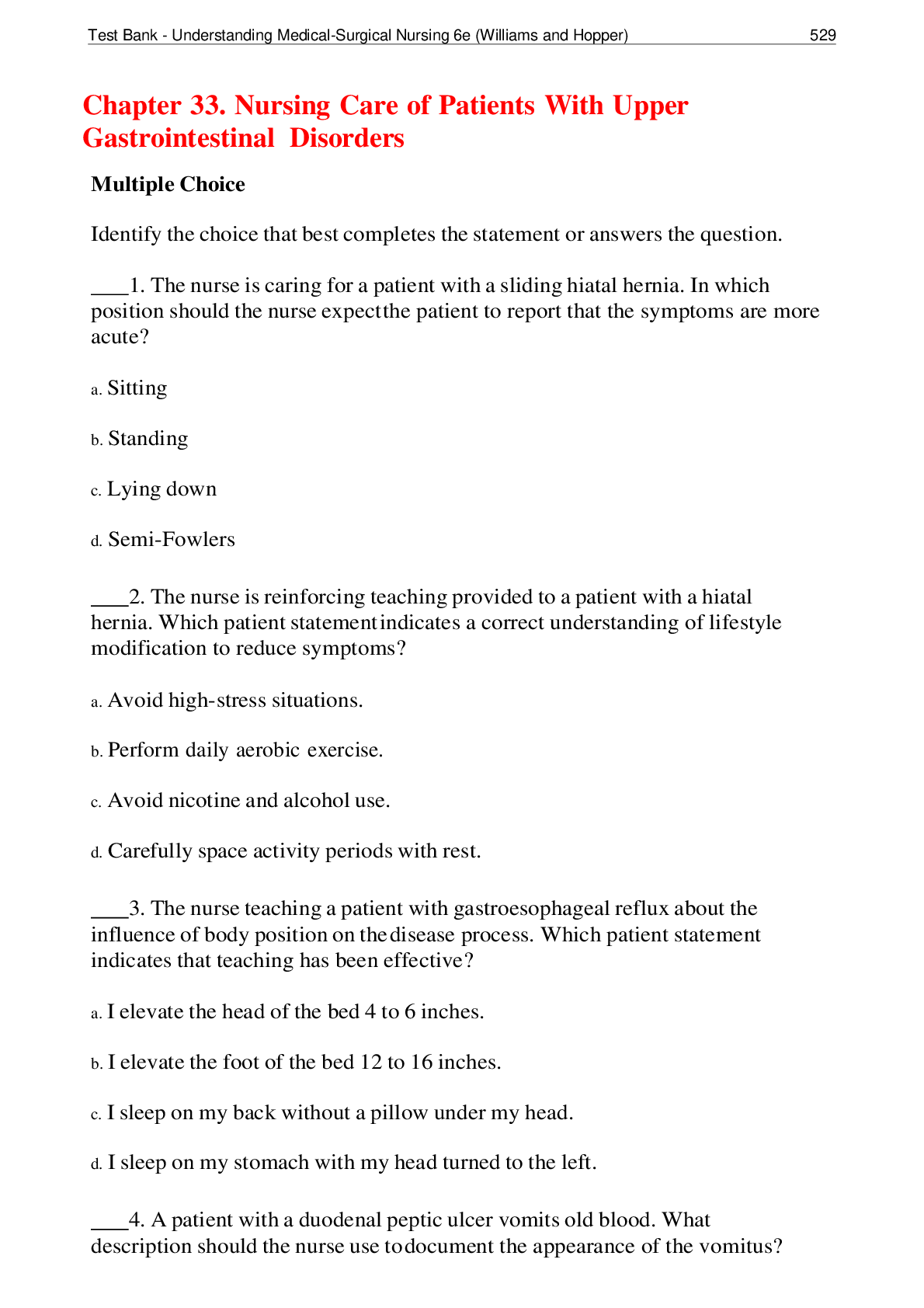
Buy this document to get the full access instantly
Instant Download Access after purchase
Add to cartInstant download
We Accept:

Reviews( 0 )
$15.00
Document information
Connected school, study & course
About the document
Uploaded On
Jan 17, 2022
Number of pages
33
Written in
Additional information
This document has been written for:
Uploaded
Jan 17, 2022
Downloads
0
Views
53













